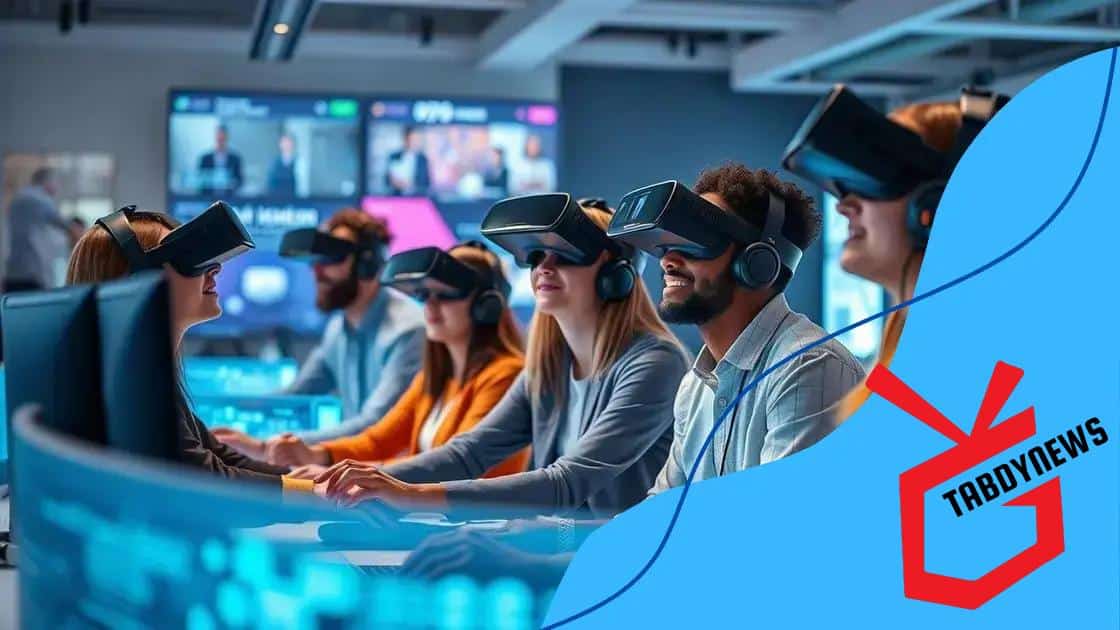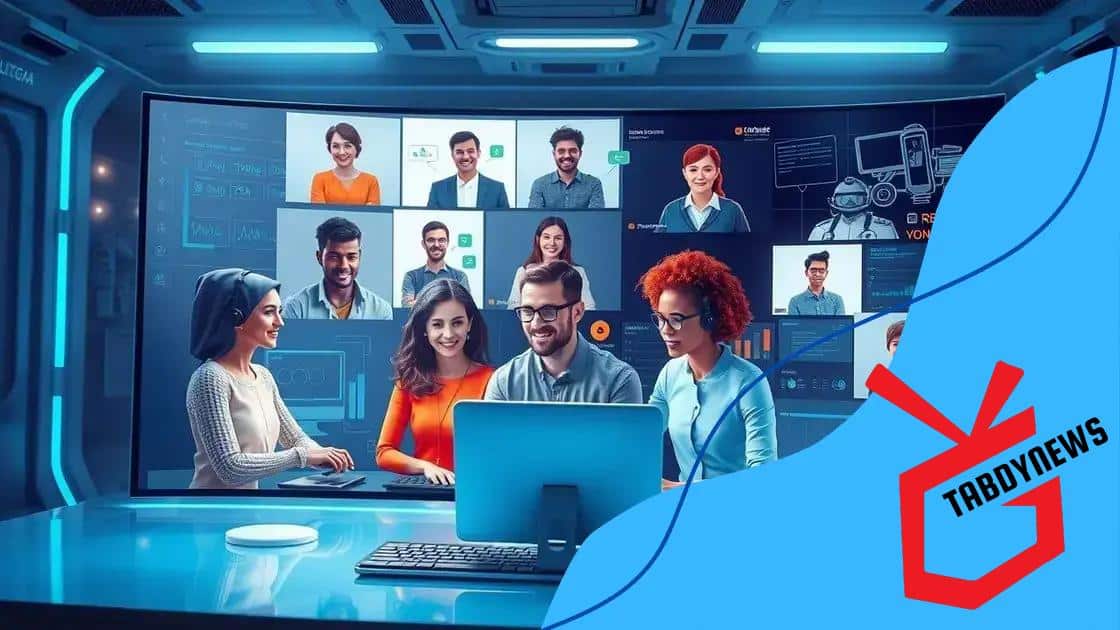Metaverse’s role in future workspaces is expanding

The metaverse’s role in future workspaces enhances collaboration, flexibility, and employee engagement while posing challenges like security risks and technological limitations.
Metaverse’s role in future workspaces is becoming increasingly significant, transforming how we think about collaboration and productivity. Have you ever imagined working in a space where digital and physical worlds seamlessly blend? Let’s dive into how this emerging landscape can shape our working lives.
Understanding the metaverse concept
Understanding the metaverse concept is crucial as it offers insights into our potential work futures. The metaverse encompasses a digital universe where people can interact, work, and create in virtual spaces. Imagine a place where your colleagues are not only in the same physical location but can also join you from anywhere in the world.
This new digital frontier uses technologies like virtual reality (VR) and augmented reality (AR) to create immersive experiences. These tools are essential for enabling remote collaboration, fostering creativity, and enhancing productivity. As we explore this concept, we can see its potential to reshape our workplaces.
Key Elements of the Metaverse
To understand the metaverse better, it’s important to look at its key elements:
- Virtual Environments: Spaces designed for interaction and collaboration.
- Digital Avatars: Personal representations in the metaverse.
- Blockchain Integration: Ensuring secure transactions and ownership.
The presence of these components creates a comprehensive digital experience. It is not just about working in isolation; the metaverse allows for shared experiences. For instance, team meetings can occur in a virtual conference room that mimics real-life interaction.
Benefits of the Metaverse
Working within the metaverse can offer various advantages:
- Enhanced Engagement: Users can immerse themselves more easily.
- Improved Flexibility: Remote workers can access workspaces without physical limitations.
- Expanded Creativity: Innovative ideas can flourish in an interactive setting.
As these features make working more engaging, they could lead to increased job satisfaction. Employees may find that they can express their ideas more freely in a virtual space compared to a traditional office.
Furthermore, the metaverse can facilitate globalization. Teams can work together seamlessly, regardless of their geographical locations. This ability not only brings diverse perspectives to projects but can also enhance problem-solving.
Key technologies driving the metaverse
The key technologies driving the metaverse are pivotal for its development and adoption. These innovations enable the immersive experiences that make the metaverse appealing for work and leisure. With the rise of virtual reality (VR), individuals can step into entirely new environments, allowing for more interactive and engaging collaboration.
Another vital technology is augmented reality (AR), which overlays digital information onto the real world. This integration helps enhance productivity by providing useful information in real-time. As these technologies advance, they lead to richer interactions, blurring the lines between physical and digital spaces.
Essential Technologies
Several key technologies are essential for the metaverse:
- Virtual Reality (VR): Offers immersive experiences through headsets.
- Augmented Reality (AR): Combines digital content with the real world.
- Blockchain: Ensures secure transactions and ownership verification.
- Artificial Intelligence (AI): Enhances user interactions and creates intelligent environments.
These technologies create a robust infrastructure for the metaverse. Each plays a distinct role in making virtual interactions seamless and enjoyable. For instance, VR permits users to assemble in simulated environments, while AR allows for enhancements in everyday tasks.
Impact of Connectivity
The evolution of 5G connectivity is also a crucial factor. With faster internet speeds and lower latency, experiences in the metaverse become smoother. Users can enjoy real-time interactions, enhancing collaboration and reducing frustrations often associated with delayed responses.
Moreover, as hardware components improve, such as more affordable VR headsets and powerful computers, access to the metaverse will broaden. This democratization of technology enables a diverse range of people to participate, enriching the virtual community.
Benefits of the metaverse for remote work

The benefits of the metaverse for remote work are becoming increasingly apparent as more companies explore virtual environments. This immersive digital space allows employees to collaborate more effectively, connecting from various locations around the world.
One significant advantage is the enhanced sense of presence. In the metaverse, team members can interact as if they are in the same room, using avatars in a shared virtual environment. This interaction fosters better communication and team cohesion compared to traditional video calls.
Key Advantages
Here are some key advantages of using the metaverse for remote work:
- Increased Collaboration: Teams can brainstorm and work together in real-time.
- Flexible Workspaces: Employees can create personalized virtual offices.
- Improved Engagement: Immersive experiences keep employees focused and motivated.
- Access to Global Talent: Companies can hire without geographical restrictions.
The flexibility offered by the metaverse is remarkable. Employees can customize their virtual workspaces, accommodating personal comforts and preferences. This customization leads to a better work-life balance and improves overall job satisfaction.
Broader Networking Opportunities
Additionally, employees gain access to broader networking opportunities within the metaverse. By participating in virtual conferences and social events, they can connect with industry leaders and peers from around the globe. This networking can inspire innovation and foster valuable partnerships.
Furthermore, companies can reduce operational costs by leveraging the metaverse. Virtual offices require less physical space, translating to savings on rent and utilities. This cost-effective solution allows companies to allocate resources toward technological advancements.
Challenges of integrating the metaverse
The challenges of integrating the metaverse are significant as organizations consider moving their operations into these virtual environments. While the benefits are tempting, several obstacles must be addressed for a successful transition.
One major challenge is technological limitations. Not all organizations have access to the latest hardware or software required for effective operation in the metaverse. Issues such as low bandwidth and outdated equipment can severely hinder the user experience.
Key Challenges
Here are some key challenges organizations face:
- Security Risks: The metaverse presents new cybersecurity threats that companies must navigate.
- Adaptation Resistance: Employees may feel hesitant to embrace new technologies and workflows.
- Interoperability: Different platforms may not work well together, complicating collaboration.
- Cost of Implementation: Setting up the necessary infrastructure can be expensive.
Additionally, security risks remain a major concern. Organizations must ensure that their data is protected from cyber threats. Implementing strong security measures can be complex, especially in a decentralizing environment like the metaverse.
Cultural Shift
Another challenge is the need for a cultural shift within organizations. Employees accustomed to traditional work practices may resist adapting to a fully digital workspace. This shift requires comprehensive training and ongoing support to build comfort with new tools and systems.
Moreover, interoperability between different metaverse platforms can create barriers. If systems can’t communicate or collaborate effectively, workflows may become fragmented, leading to frustration among users. To succeed, organizations need to focus on finding compatible solutions.
Future trends in workspace evolution
The future trends in workspace evolution are set to significantly impact how we work. As technology continues to advance, the workplace will change in ways we may only begin to imagine. One prominent trend is the shift towards more flexible workspaces. Employees are increasingly valuing the ability to choose where and how they work, leading to a rise in hybrid models.
This flexibility means individuals can work from home, in a coffee shop, or from a traditional office space. Companies will need to adapt to support these diverse settings. Providing the right tools and technologies will be essential in this new environment.
Key Trends to Watch
Here are several key trends shaping the future of workspaces:
- Remote Collaboration Tools: The need for effective communication platforms will grow.
- AI and Automation: More tasks will be automated, allowing employees to focus on creative work.
- Increased Use of VR and AR: These technologies will enhance virtual meetings and training sessions.
- Emphasis on Health and Well-being: Workspaces will focus on creating healthier environments for productivity.
In addition to these trends, as remote work becomes the norm, companies will prioritize employee well-being. This trend recognizes that mental and physical health is crucial for maintaining high levels of productivity. Employers may offer more support through wellness programs and flexible scheduling.
The Role of Sustainability
Another critical aspect is sustainability. Organizations will increasingly seek to create eco-friendly workspaces. Incorporating green technologies and sustainable practices not only benefits the environment but also appeals to employees who prioritize corporate responsibility.
As the metaverse becomes more integrated into our daily lives, it will further transform workspace dynamics. Virtual environments will enable new forms of collaboration and creativity. Employees can interact more freely, breaking down traditional barriers imposed by physical spaces.
FAQ – Frequently Asked Questions about the Metaverse in Future Workspaces
What are the main benefits of using the metaverse for remote work?
The metaverse enhances collaboration, provides flexible workspaces, fosters creativity, and improves employee engagement.
How does the metaverse improve communication among teams?
By using avatars and virtual environments, team members can interact in more engaging ways, mimicking real-life communication.
What challenges do companies face when integrating the metaverse?
Challenges include technological limitations, security risks, employee adaptation resistance, and interoperability between different platforms.
How can organizations ensure employee well-being in a metaverse workspace?
Organizations can prioritize mental health support, create healthier environments, and promote work-life balance to enhance employee well-being.





